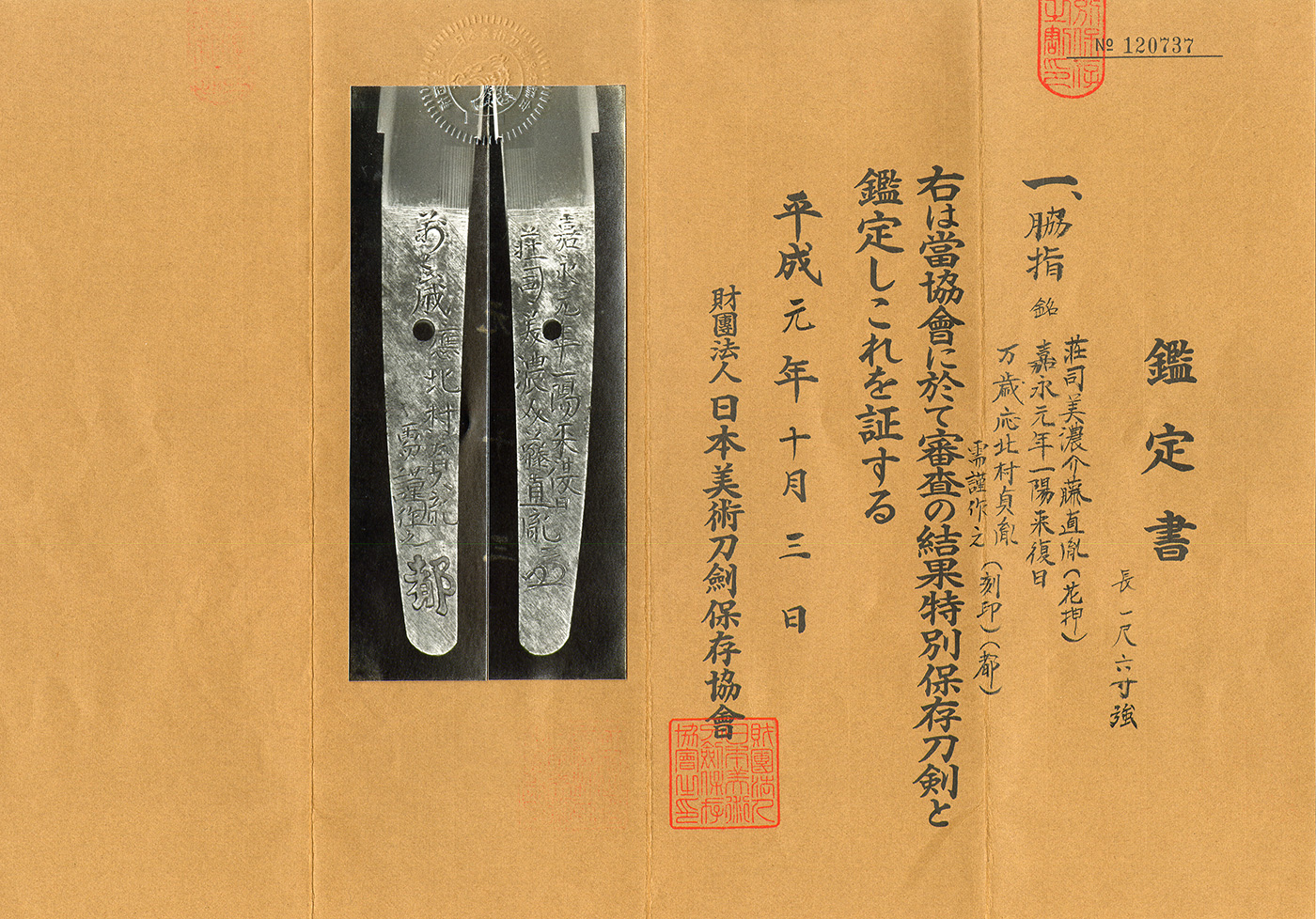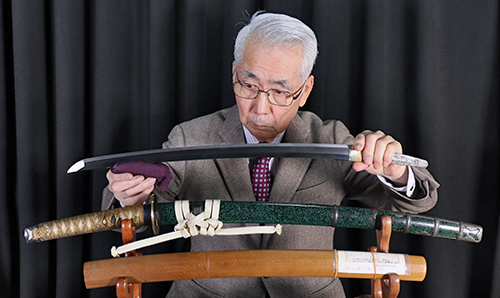Ordering number:23519
Wakizashi in Shirasaya with Koshirae (NBTHK Tokubetsu Hozon Token)
Signature: Soji Mino Suke Fuji Naotana(Kao)
Kaei Gan Nen Ichiyoraifuku Bi
Banzai Ou Kitamura Sadatane Ju Kinsaku Kore(Kokuin)(To)
荘司美濃介藤直胤(花押)
嘉永元年一陽来復日
万歳応北村貞胤需僅作之(刻印)(都)
Explanation: Naotane made this Wakizashi for Mr.Kitamura Sadatane in the winter solstice 1848.
Shinshinto: Saijyo Saku: Musashi
We divide 4 sections for each sword as Saijyo Saku, Jyojyo Saku, Jyo Saku, and Regular Saku.
This work is ranked as Jyojyo Saku for the creations by Naotane.
Polished
Habaki: Single gold foil
Blade Length: 46.6 cm (18.35 in)
Curvature: 1.2 cm (0.47 in)
Mekugi Hole: 1
Width at Base (Motohaba): 2.79 cm (1.10 in)
Width at the Tip (Sakihaba): 1.95 cm (0.77 in)
Thickness of Rim (Kasane): 0.67 cm (0.26 in)
Sword Weight: 440 grams
Era: Late Edo period, first year of Kaei 1848
Shape: The body width is regular, thickness slightly thicker, with a deep curve.
The tip is slightly elongated, a good solid shape.
Jigane: Itame Hada mixed with Mokume Hada, with clear skin patterns visible.
Hamon: Straight edge with small Asbi, Sunagashi, and Kinsuji plays, the boshi is Komaru with a return, followed by a sweeping and Kinsuji activity.
Features: Taikei Naotane was born in Dewa Province and received the title of Chikuzen Daijo in Bunsei 4. Later, he moved to Edo and became a pupil of Suishinshi Masahide. There, he learned various traditions like Bizen and Soshu, and gained reputation for techniques called “coming out of indigo.” Unlike his master promoting restored swords, Naotane created unique pieces with spiral Jigane, significantly differing from his teacher’s style.
Koshirae: Half Tachi Koshirae
Tsuba: Red copper ground with gold-covered rim
Fuchikashira: Red copper ground
Menuki: Design of shiitake mushrooms, carved in high relief and colored with gold.
Saya: Unusually patterned with green and black, a rare design.
Kojiri: Decorated with iron around.
Kogatana: Quarter ground with a figure thought to be a demon, depicted glaring at his opponent.
Kogatana:None*
Aoi Art’s Comment: Taikei Naotane was one of the most well-known swordsmiths in the late Edo period, excelling in traditions like Bizen, Soshu, Mino, and Yamato. This piece, with its long size and deep curve, resembles an old Bizen and might be confused with Kuniyoshi. Previously, a similar piece by Naotane depicting an old sword in the style of Soshu tradition was recognized as an important art piece, which was magnificent. This work also looks like an old sword and is highly recommended. The quality of iron improved gradually over the periods of Bunka, Bunsei, and Tenpo, culminating in the late Edo period as wars became more frequent, prompting clans to demand better-quality swords. This piece introduces a fine old-style Hamon, well-kneaded Jitetsu, and active straight Hamon with gold streaks; the variations in the boshi are also impressive.
*This Koshirae doesn’t have a Kogatana. Please understand it before the order.
NBTHK Tokubetsu Hozon Token
AoiArt estimation paper
Whole Oshigata






